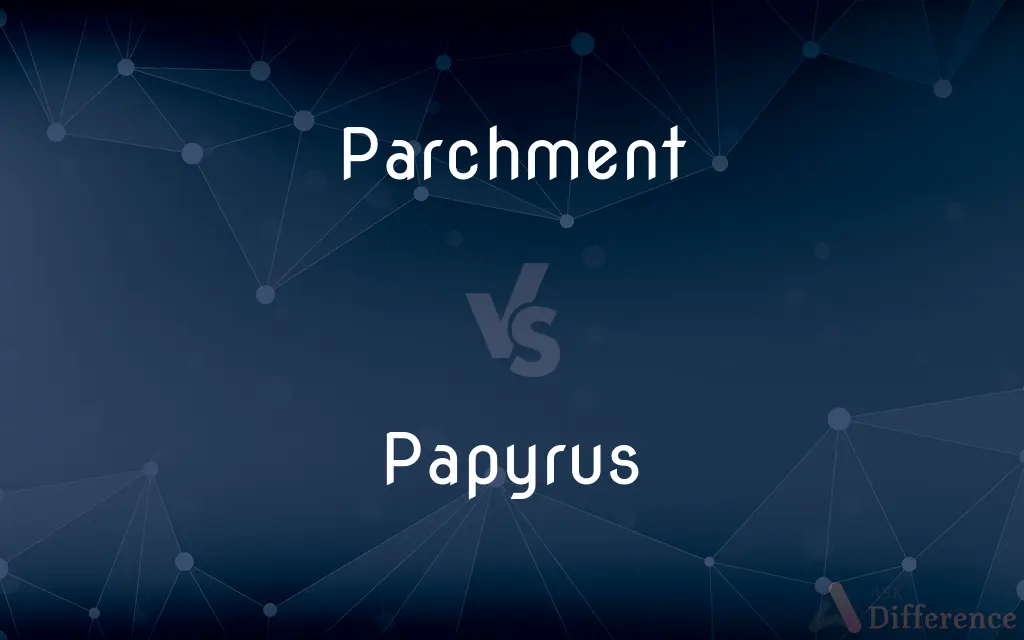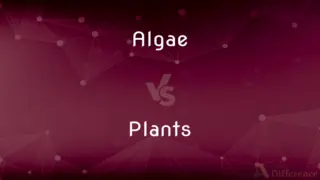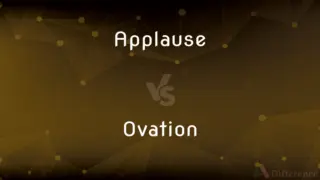Parchment vs. Papyrus — What's the Difference?
By Maham Liaqat & Fiza Rafique — Updated on March 31, 2024
Parchment, a writing material made from animal skins, is durable and can be reused; papyrus, derived from the papyrus plant, was the preferred choice in ancient times for its ease of production.

Difference Between Parchment and Papyrus
Table of Contents
ADVERTISEMENT
Key Differences
Parchment is made from the skins of animals, mainly sheep, goats, and calves, treated to create a smooth, durable writing surface. Whereas papyrus, made from the pith of the papyrus plant native to the Nile Delta in Egypt, involves cutting the plant into thin strips, which are then soaked, pressed, and dried to form sheets.
Parchment's durability and resistance to moisture made it the preferred material for important documents in medieval Europe, where it was used for manuscripts, legal documents, and religious texts. On the other hand, papyrus, being more susceptible to decay in moist climates, was primarily used in ancient Egypt and the surrounding dry regions, where its properties were suitable for the local environment.
The production of parchment is more labor-intensive and costly compared to papyrus, which contributed to its status as a premium writing material in the past. Papyrus, while less durable, was more accessible and cost-effective for everyday use in ancient times, especially in Egypt where the papyrus plant was abundant.
Parchment enabled the creation of codices (book-like manuscripts), which were more compact and easier to use than the scrolls typical of papyrus. This shift significantly influenced the spread and preservation of knowledge in medieval Europe. Whereas papyrus scrolls, being easier to produce and transport, were the dominant form of book in the ancient Mediterranean and Near East for centuries.
Despite parchment's dominance in medieval Europe, the invention of paper eventually led to its decline as the primary writing material. However, papyrus also saw a decline with the advent of paper, which was cheaper and easier to produce than both parchment and papyrus, marking a shift in writing material technology across the world.
ADVERTISEMENT
Comparison Chart
Material Source
Animal skins (sheep, goats, calves)
Pith of the papyrus plant
Durability
High, resistant to moisture
Lower, susceptible to decay in moist environments
Production Process
Labor-intensive (removal of hair, stretching, and drying)
Less labor-intensive (cutting, soaking, pressing, and drying strips)
Historical Usage
Preferred in medieval Europe for important documents
Widely used in ancient Egypt and the Mediterranean
Cost
More costly due to labor-intensive production
More cost-effective, especially in regions where papyrus was abundant
Compare with Definitions
Parchment
A writing material made from specially treated animal skins.
Medieval manuscripts were often written on parchment.
Papyrus
Utilized primarily in Egypt and the Mediterranean region.
Papyrus was the primary writing material in ancient times along the Nile.
Parchment
Reusable after erasing the previous text.
Scholars reused parchment by scraping off old writings.
Papyrus
An early form of paper made from the papyrus plant.
Ancient Egyptian texts were commonly written on papyrus.
Parchment
Known for its durability and longevity.
Parchment has survived centuries without significant decay.
Papyrus
Used for creating scrolls, the precursor to modern books.
Scrolls made of papyrus were the standard format for texts in antiquity.
Parchment
Used historically for important documents.
The charter was inscribed on parchment.
Papyrus
Less durable than parchment, susceptible to moisture.
Many papyrus documents have deteriorated in damp climates.
Parchment
More expensive and labor-intensive to produce than papyrus.
The production of parchment was reserved for the most valued texts.
Papyrus
Easier and cheaper to produce than parchment.
The availability of the papyrus plant made it a popular choice for writing materials.
Parchment
Parchment is a writing material made from specially prepared untanned skins of animals—primarily sheep, calves, and goats. It has been used as a writing medium for over two millennia.
Papyrus
Papyrus ( pə-PYE-rəs) is a material similar to thick paper that was used in ancient times as a writing surface. It was made from the pith of the papyrus plant, Cyperus papyrus, a wetland sedge.
Parchment
The skin of a sheep or goat prepared as a material on which to write or paint.
Papyrus
An aquatic sedge (Cyperus papyrus) native to Africa, having a tall stem and an umbellate inflorescence with numerous arching rays.
Parchment
A written text or drawing on a sheet of this material.
Papyrus
A material made from the pith or the stems of this sedge, used by the ancient Egyptians, Greeks, and Romans especially to write or paint on.
Parchment
Paper made in imitation of this material.
Papyrus
A document written on this material.
Parchment
Material, made from the polished skin of a calf, sheep, goat or other animal, used like paper for writing.
Papyrus
A plant (Cyperus papyrus) in the sedge family, native to the Nile river valley, paper reed.
Parchment
A document made on such material.
Papyrus
A material similar to paper made from the papyrus plant.
Parchment
A diploma (traditionally written on parchment).
Papyrus
(countable) A scroll or document written on papyrus.
Parchment
Stiff paper imitating that material.
Papyrus
A tall rushlike plant (Cyperus Papyrus) of the Sedge family, formerly growing in Egypt, and now found in Abyssinia, Syria, Sicily, etc. The stem is triangular and about an inch thick.
Parchment
The creamy to tanned color of parchment.
Papyrus
The material upon which the ancient Egyptians wrote. It was formed by cutting the stem of the plant into thin longitudinal slices, which were gummed together and pressed.
Parchment
The envelope of the coffee grains, inside the pulp.
Papyrus
A manuscript written on papyrus; esp., pl., written scrolls made of papyrus; as, the papyri of Egypt or Herculaneum.
Parchment
The skin of a lamb, sheep, goat, young calf, or other animal, prepared for writing on. See Vellum.
But here's a parchment with the seal of Cæsar.
Papyrus
Paper made from the papyrus plant by cutting it in strips and pressing it flat; used by ancient Egyptians and Greeks and Romans
Parchment
The envelope of the coffee grains, inside the pulp.
Papyrus
Tall sedge of the Nile valley yielding fiber that served many purposes in historic times
Parchment
A superior paper resembling sheepskin
Papyrus
A document written on papyrus
Parchment
Skin of a sheep or goat prepared for writing on
Common Curiosities
Which was more expensive to produce, parchment or papyrus?
Parchment was more expensive to produce due to its labor-intensive preparation process compared to the simpler process for making papyrus.
Why did parchment replace papyrus as a writing material?
Parchment replaced papyrus due to its greater durability, moisture resistance, and suitability for making codices, which were easier to use than scrolls.
How was papyrus produced?
Papyrus was produced by cutting the papyrus plant into thin strips, which were then soaked, pressed together, and dried to form sheets.
Why was parchment more durable than papyrus?
Parchment was more durable due to its animal skin base, which is more resistant to moisture and decay than the plant-based papyrus.
What led to the decline of both parchment and papyrus?
The invention of paper, which was cheaper and easier to produce, led to the decline of both parchment and papyrus as primary writing materials.
Are parchment and papyrus still used today?
They are used primarily for restoration purposes or artistic endeavors, not as common writing materials.
Was papyrus used outside of Egypt?
Yes, papyrus was also widely used in the ancient Mediterranean and Near East, though it was most common in Egypt.
What was the primary format of papyrus documents?
Papyrus documents were primarily made in the form of scrolls.
Can parchment be reused?
Yes, parchment can be reused by scraping off the previous writing, a process known as palimpsest.
What is parchment made from?
Parchment is made from the skins of animals, such as sheep, goats, and calves, treated to create a smooth writing surface.
Were ancient texts only written on parchment and papyrus?
While many were, other materials like clay tablets, wooden tablets, and silk were also used for writing in various parts of the world.
How did the climate affect the use of papyrus and parchment?
Papyrus was more suited to dry climates like Egypt's, where it was less likely to decay, whereas parchment was better for varied climates due to its durability.
How did the switch from scrolls to codices impact parchment use?
The switch favored parchment, as its durability and flexibility were more suited to the codex format, leading to its increased use.
How were parchment and papyrus prepared for writing?
Parchment required treatment and stretching of animal skins, while papyrus needed cutting, soaking, and pressing of plant strips.
Did the use of parchment and papyrus overlap in history?
Yes, there was a significant period during which both materials were used, though in different regions and for different purposes.
Share Your Discovery

Previous Comparison
Algae vs. Plants
Next Comparison
Applause vs. OvationAuthor Spotlight
Written by
Maham LiaqatCo-written by
Fiza RafiqueFiza Rafique is a skilled content writer at AskDifference.com, where she meticulously refines and enhances written pieces. Drawing from her vast editorial expertise, Fiza ensures clarity, accuracy, and precision in every article. Passionate about language, she continually seeks to elevate the quality of content for readers worldwide.















































